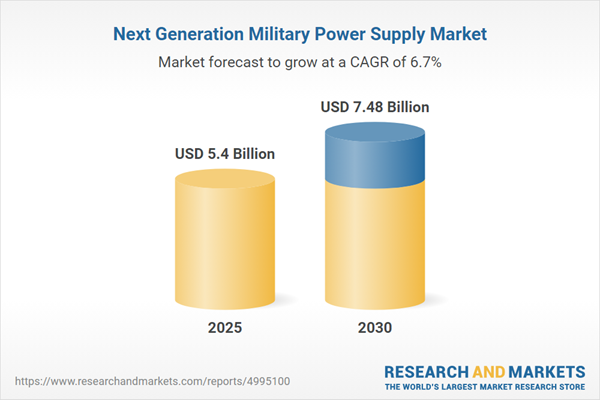Speak directly to the analyst to clarify any post sales queries you may have.
As military operations become increasingly reliant on advanced technologies, robust and adaptable power supply systems are fundamental to both mission success and operational agility. Senior decision-makers are prioritizing next generation military power supply solutions that support evolving defense strategies and technological advancements.
Next Generation Military Power Supply Market Snapshot
The next generation military power supply market grew from USD 5.08 billion in 2024 to USD 5.40 billion in 2025. It is expected to maintain a compound annual growth rate (CAGR) of 6.66%, reaching USD 7.48 billion by 2030. Recent analysis reveals that innovation in energy storage, modular architectures, and hybrid microgrid solutions is reshaping defense procurement and capability planning across all major theaters. Evolving operational imperatives are driving investments in reliable, digital, and sustainable energy supply platforms tailored for complex multi-domain environments.
Scope & Segmentation
This report delivers an in-depth analysis of the next generation military power supply market, focusing on segmentation by product, application, end user, and geographic region to support more informed strategy and procurement decisions.
- Component: Hardware (Batteries, Fuel Cells, Generators, Power Conditioning Units, Solar Power Systems), Software
- Type: Non-Programmable Power Supply, Programmable Power Supply
- Power Output: High Power (>5 kW), Low Power (< 1 kW), Medium Power (1–5 kW)
- Installation Type: Portable, Stationary
- Application: Command Center Power, Directed Energy Weapon Power, Electronic Warfare Power, Portable Soldier Power, Surveillance and Sensor Power, UAV and Drone Power
- End User: Air Force, Army, Navy
- Regions: Americas (North America: United States, Canada, Mexico; Latin America: Brazil, Argentina, Chile, Colombia, Peru), Europe, Middle East & Africa (Europe: United Kingdom, Germany, France, Russia, Italy, Spain, Netherlands, Sweden, Poland, Switzerland; Middle East: United Arab Emirates, Saudi Arabia, Qatar, Turkey, Israel; Africa: South Africa, Nigeria, Egypt, Kenya), Asia-Pacific (China, India, Japan, Australia, South Korea, Indonesia, Thailand, Malaysia, Singapore, Taiwan)
- Key Companies: Aegis Power Systems Inc., AJ's Power Source Inc., Astrodyne TDI Corporation by Tinicum L.P., Concorde Battery Corporation, Cummins Inc., Denchi Group Ltd., Eaton Corporation plc., EnerSys, Eniquest Pty. Ltd., Fujitsu Limited, Milpower Source Inc., Mitsubishi Electric Corporation, Mornsun Guangzhou Science & Technology Co., Ltd., Saft Groupe SAS by TotalEnergies SE, SFC Energy AG, Synqor, Inc., TDK Corporation, Texas Instruments Incorporated, Advanced Conversion Technology, Inc., AGMA Power Systems Ltd., General Motors Defense LLC, Intelligent Energy Limited, Abbott Technologies, Inc.
Key Takeaways: Strategic Insights for Decision-Makers
- Digitalization and autonomy are increasing demand for intelligent power management and high-density storage designed for rugged, unpredictable environments.
- Integration of hybrid and renewable energy systems is reducing logistical complexity, addressing sustainability mandates, and enhancing strategic flexibility for deployed units.
- Regional defense priorities influence technology adoption, with localized manufacturing and strategic partnerships mitigating supply chain risks and compliance with defense standards.
- Industry investment is focusing on scalable, modular design architectures that support rapid configuration for both legacy upgrades and new platforms.
- Collaboration between traditional defense primes and innovative start-ups is accelerating the development of AI-enabled and network-resilient power solutions.
Tariff Impact and Regulatory Adjustments
US tariff policies introduced in 2025 have reshaped supply chain dynamics by raising costs for key components and incentivizing domestic manufacture of advanced batteries, power converters, and specialty metals. These measures are prompting closer public-private collaboration and new incentive programs to reinforce domestic production capacity. Efforts now emphasize modular designs and flexibility in component sourcing to ensure operational resilience under fluctuating regulatory conditions.
Methodology & Data Sources
This report is based on comprehensive primary research, including interviews with senior defense procurement officials and technology officers, as well as secondary analysis of white papers, technical journals, and government policies. Data triangulation and scenario modeling ensure findings reflect real-world operational realities and anticipated trends.
Why This Report Matters
- Equips stakeholders with granular segmentation and actionable insights, supporting targeted R&D, investment, and integration strategies within the military power supply ecosystem.
- Provides clarity on the regulatory and supply chain landscape, assisting organizations in making decisions that safeguard long-term operational readiness and competitiveness.
Conclusion
The next generation military power supply market will continue to evolve as stakeholders align innovation with emerging mission needs, supply chain demands, and strategic sustainability goals. This analysis empowers decision-makers to navigate change and capitalize on new opportunities in defense energy solutions.
Additional Product Information:
- Purchase of this report includes 1 year online access with quarterly updates.
- This report can be updated on request. Please contact our Customer Experience team using the Ask a Question widget on our website.
Table of Contents
3. Executive Summary
4. Market Overview
7. Cumulative Impact of Artificial Intelligence 2025
Companies Mentioned
The companies profiled in this Next Generation Military Power Supply market report include:- Aegis Power Systems Inc.
- AJ’s Power Source Inc.
- Astrodyne TDI Corporation by Tinicum, L.P.
- Concorde Battery Corporation
- Cummins Inc.
- Denchi Group Ltd.
- Eaton Corporation plc.
- EnerSys
- Eniquest Pty. Ltd.
- Fujitsu Limited
- Milpower Source Inc.
- Mitsubishi Electric Corporation
- Mornsun Guangzhou Science & Technology Co., Ltd.
- Saft Groupe SAS by TotalEnergies SE
- SFC Energy AG
- Synqor, Inc.
- TDK Corporation
- Texas Instruments Incorporated
- Advanced Conversion Technology, Inc.
- AGMA Power Systems Ltd.
- General Motors Defense LLC
- Intelligent Energy Limited
- Abbott Technologies, Inc.
Table Information
| Report Attribute | Details |
|---|---|
| No. of Pages | 192 |
| Published | November 2025 |
| Forecast Period | 2025 - 2030 |
| Estimated Market Value ( USD | $ 5.4 Billion |
| Forecasted Market Value ( USD | $ 7.48 Billion |
| Compound Annual Growth Rate | 6.6% |
| Regions Covered | Global |
| No. of Companies Mentioned | 24 |









